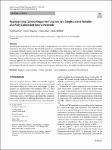Item Infomation
Full metadata record
| DC Field | Value | Language |
|---|---|---|
| dc.contributor.author | Yunfeng, Zhao | - |
| dc.contributor.author | Stuart, Ferguson | - |
| dc.contributor.author | Huiyu, Zhou | - |
| dc.date.accessioned | 2023-04-24T07:02:20Z | - |
| dc.date.available | 2023-04-24T07:02:20Z | - |
| dc.date.issued | 2022 | - |
| dc.identifier.uri | https://link.springer.com/article/10.1007/s11760-022-02351-8 | - |
| dc.identifier.uri | https://dlib.phenikaa-uni.edu.vn/handle/PNK/8246 | - |
| dc.description | CC BY | vi |
| dc.description.abstract | Modelling the mapping from scene irradiance to image intensity is essential for many computer vision tasks. Such mapping is known as the camera response. Most digital cameras use a nonlinear function to map irradiance, as measured by the sensor to an image intensity used to record the photograph. Modelling of the response is necessary for the nonlinear calibration. In this paper, a new high-performance camera response model that uses a single latent variable and fully connected neural network is proposed. The model is produced using unsupervised learning with an autoencoder on real-world (example) camera responses. Neural architecture searching is then used to find the optimal neural network architecture. A latent distribution learning approach was introduced to constrain the latent distribution. | vi |
| dc.language.iso | en | vi |
| dc.publisher | Springer | vi |
| dc.subject | Representing Camera Response Function | vi |
| dc.subject | Fully Connected Neural Network | vi |
| dc.title | Representing Camera Response Function by a Single Latent Variable and Fully Connected Neural Network | vi |
| dc.type | Book | vi |
| Appears in Collections | ||
| OER - Công nghệ thông tin | ||
Files in This Item:

